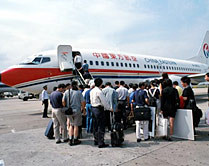
More than 129 million people crossed China's borders in the first six months of this year, 30.78 percent more than last year.
Statistics from the Exit-Entry Administration of the Ministry of Public Security revealed that more than 26.3 million of those people were Chinese mainlanders, 84.5 million Hong Kong and Macao residents, 3.35 million Taiwan residents and 14.79 million foreigners.
The figures are much higher than those from last year's SARS-tainted numbers, during which an obvious decline was seen for the first time in 13 years of continual growth, said a the ministry official who declined to be identified.
This year's increase can also be attributed to simplified examination procedures at border checkpoints, he added.
However, the growth may simply be caused by easier access to passports and visas by Chinese citizens, said Xiang Dang, a professor with the Chinese People's Public Security University.
By the end of 2005, citizens in all large or medium-sized Chinese cities could apply for passports freely, said the ministry.
At the same time, some 28 foreign countries have become approved tourism destinations for groups of Chinese citizens, said Xiang.
Also, higher incomes have allowed more and more Chinese people to travel abroad.
Statistics show that the number of exits from the Chinese mainland rose 62.65 percent to 13.33 million. More than 73 percent of them went to Hong Kong or Macao.
Meanwhile, Japan was the leading foreign destination, followed by Russia, Thailand, ROK, Viet Nam, the United States and Singapore, it said.
Recreational travel and business trips accounted for 20.69 percent and 19.30 percent of the exit flow, the administration said.
On the other hand, China also attracted more overseas people to invest, Xiang noted.
More than 7.47 million people from 225 countries and regions entered Chinese mainland during the first six months this year, 61 percent more than last year. The largest flow of people came from Japan and the Republic of Korea (ROK), 19 percent and 16.7 percent respectively.
Countries that also had a high percentage of entry applicants were Russia, the United States, Malaysia, Singapore, the Philippines, Mongolia, Thailand and Britain, statistics showed.
About 40.7 percent of the entries were for sightseeing and recreation; 16.69 percent were on business trips, it said.
Still, some 35,200 violators and criminal suspects were caught at border checkpoints this year. Of those, 2,988 were illegal exit-and-entry cases.
The growth in arrests shows that China's borders have tightened examinations, said Professor Xiang, adding human smuggling is still growing around the world.
(China Daily July 16, 2004)
|

